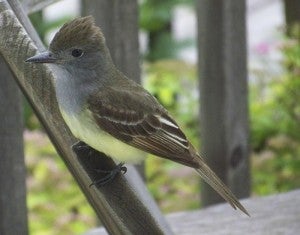The wonders of fall are around us
Published 9:10 am Saturday, September 25, 2010
Al Batt, Nature’s World
My neighbor Crandall stops by.
“How are you doing?” I ask.
“Everything is nearly copacetic. I’m living happily ever after. I spent yesterday wearing a V-necked sweater while eating a T-bone steak in an A-frame house while thinking about old black-and-white filmstrips about A-bombs and illegal U-turns.”
“Well, at least you weren’t wasting time,” I interject.
“Now it might all be coming to an end. Some guy from the county stopped by yesterday. It seems they want to tear my house down to make room for a vacant lot. It has something to do with their beautification program. He made me a tempting offer. The money would come in handy. I’ve been saving up for a new tire. I’m not sure I’ll take the offer. There is a lot of family history there. Pop was born in that house. Speaking of Pop, he can still eat pizza without taking the cigar out of his mouth, but lately, he’s been eating a lot of celery. He’s a little hard of hearing and with celery, he can always tell when he’s done eating. Grandpappy built that house. He never quite finished it. Now he only opens his eyes to yawn. I’ve been meaning to finish the shack but I haven’t been able.”
“Why, because of the economy?” I ask.
“No, because I ran out of duct tape.”
Fall
It is time to start doing the spring cleaning.
That’s right, it’s fall. I need to post signs around my yard that read, “Beware of falling leaves.”
Linus Van Pelt said, “Never jump into a pile of leaves with a wet sucker.”
I mow the lawn for the last time of the season in the fall. Sometimes I mow the lawn for the last time of the season a number of times.
George Eliot wrote, “Delicious autumn! My very soul is wedded to it, and if I were a bird I would fly about the earth seeking the successive autumns.”
I love waking up to a cool pillow. There is a morning chill, a gift for making it through the sultry days. I love that crisp morning air and the blue sky. We all too quickly slide through a season. Another year attempts to wriggle from our grasp. I know the snow will be whipped by winds before I know it, so I need to enjoy the fall days as much as possible. Momentary blessings are precious.
Birds become quiet but insects continue to be vocal. The landscape becomes a symphony in sepia. Colors fade yet become more brilliant.
William Cullen Bryant penned this, “The melancholy days have come, the saddest of the year; Of wailing winds, and naked woods, and meadows brown and sere; Heaped in the hollows of the grove, the autumn leaves lie dead; They rustle to the eddying gust, and to the rabbit’s tread; The robin and the wren are flown, and from the shrubs the jay; And from the wood-top calls the crow through all the gloomy day.”
To those who feel that way about fall, I recommend that when we amend the daylight-saving time change and we fall back, we set the clocks back eight hours. We could preserve shrinking daylight hours for play instead of work.
Q and A
“What is the recipe for the solution to neutralize skunk spray on a dog?” Mix 1 quart of 3 percent hydrogen peroxide, 1 cup baking soda, and 1 teaspoon liquid soap. Wash the sprayed animal for 5 to 10 minutes. Keep the mixture out of eyes, nose and mouth. Rinse with tap water. This mixture is the size for a small dog. Double it for a medium-sized dog and triple for a large dog.
“What makes for brilliant fall colors?” The brilliance and the quantity of leaf colors that develop are related to weather conditions that occur before and during the time that chlorophyll in the leaves is dwindling. Temperature and moisture are the main influences.
A succession of warm, sunny days and cool, crisp, but not freezing nights seems to bring about the most spectacular color displays.
“What’s the difference between a pigeon and a dove?” Not much. Doves are sometimes considered smaller than pigeons, but this is not always the case. Pigeons and doves are all members of the family Columbidae.
“I see a big, black-and-yellow spider suspended in the center of a large web? What is it?” It will have a white, zigzagging pattern of silk running vertically beneath the spider. It is an argiope. It goes by many other names such as garden spider, writing spider, signature spider, banana spider and corn spider. The zigzagging pattern of silk, called the stabilimentum, is variously thought to camouflage the spider, attract insect prey or make it easy for birds to see the web so they won’t damage it by flying into it. The little brown males are about a third the size of the females.
Nature lessons
In just 14 days, a monarch butterfly caterpillar devours enough milkweed leaves to grow to more than 2,000 times its hatching weight.
American goldfinches molt body feathers twice a year, once in late winter and again in late summer. The bright yellow of male goldfinches in spring is one welcome sign of approaching warm months. Young male goldfinches do not turn a bright lemon yellow until their second summer. Although goldfinches grow a new set of feathers during molting periods in fall and spring, they continue to visit feeders during this time. Goldfinches move around when they’re not nesting and sometimes appear to have completely disappeared. Even when abundant at feeders, goldfinches move a great deal. The goldfinches frequenting feeders in the morning could be different birds than those at the same feeders in the afternoon.
Each year, people tell me that they keep flies out of buildings by filling Ziploc plastic bags with water and hanging them just outside the door. I’ve never tried that.
Thanks for stopping by
“You must not know too much or be too precise or scientific about birds and trees and flowers and watercraft; a certain free-margin, and even vagueness — ignorance, credulity — helps your enjoyment of these things.” — Walt Whitman
“Keep me away from the wisdom which does not cry, the philosophy which does not laugh, and the greatness which does not bow before children.” — Kahlil Gibran
DO GOOD.
Al Batt of Hartland is a member of the Albert Lea Audubon Society. E-mail him at SnoEowl@aol.com.






